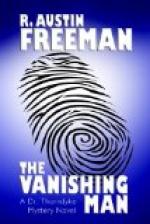“If you mean pronated in relation to the arm, that is impossible, for the position of the egg-patches shows clearly that the bones of the arm were lying in the position of supination. Thus the dorsal surface of the arm and the palmar surface of the hand respectively were uppermost, which is an anatomical impossibility so long as the hand is attached to the arm.”
“But might not the hand have become detached after lying in the pond some time?”
“No. It could not have been detached until the ligaments had decayed, and if it had been separated after the decay of the soft parts, the bones would have been thrown into disorder. But the egg-patches are all on the palmar surface, showing that the bones were still in their normal relative positions. No, Berkeley, that hand was thrown into the pond separately from the arm.”
“But why should it have been?” I asked.
“Ah, there is a very pretty little problem for you to consider. And, meantime, let me tell you that your expedition has been a brilliant success. You are an excellent observer. Your only fault is that when you have noted certain facts you don’t seem fully to appreciate their significance—which is merely a matter of inexperience. As to the facts that you have collected, several of them are of prime importance.”
“I am glad you are satisfied,” said I, “though I don’t see that I have discovered much excepting those snails’ eggs; and they don’t seem to have advanced matters very much.”
“A definite fact, Berkeley, is a definite asset. Perhaps we may presently find a little space in our Chinese puzzle which this fact of the detached hand will just drop into. But, tell me, did you find nothing unexpected or suggestive about those bones—as to their number and condition, for instance?”
“Well, I thought it a little queer that the scapula and clavicle should be there. I should have expected him to cut the arm off at the shoulder-joint.”
“Yes,” said Thorndyke; “so should I; and so it has been done in every case of dismemberment that I am acquainted with. To an ordinary person, the arm seems to join on to the trunk at the shoulder-joint, and that is where he would naturally sever it. What explanation do you suggest of this unusual mode of severing the arm?”
“Do you think the fellow could have been a butcher?” I asked, remembering Dr. Summers’ remark. “This is the way a shoulder of mutton is taken off.”
“No,” replied Thorndyke. “A butcher includes the scapula in a shoulder of mutton for a specific purpose, namely, to take off a given quantity of meat. And also, as a sheep has no clavicle, it is the easiest way to detach the limb. But I imagine a butcher would find himself in difficulties if he attempted to take off a man’s arm in that way. The clavicle would be a new and perplexing feature. Then, too, a butcher does not deal very delicately with his subject; if he has to divide a




